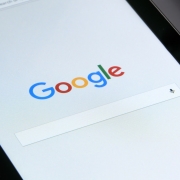- The most relevant SEO News for February 2020 - 26. February 2020
- The most relevant SEO News for January 2020 - 21. January 2020
- The most relevant SEO News for December 2019 - 23. December 2019
- The most relevant SEO News for November 2019 - 25. November 2019
- Don’t be afraid of Google’s BERT - 31. October 2019
- The most relevant SEO News for October 2019 - 31. October 2019
- The most relevant SEO News for September 2019 - 25. September 2019
Nope, no SEO trends for 2019 at this point – definitely not. Someone else can take care of that. Instead in the first SEO newsletter of the new year, we take a look at what makes life really exciting: contrasts and conflict. Having said that, anyone who thought we might get involved in the current gender discussion can rest easy. We are sticking with search engines and, more precisely, the antagonism of range versus conversion, as well as the eternal SEA versus SEO dichotomy.
SEO & CRO: A relationship with conflict potential
A high retention time for the domain, high numbers of page views per visit, the use of rich media and finally conversion, for example in the form of a purchase or a lead, all represent positive user signals which are usually achieved by search engines with increased visibility. This means the top priority of the search engine optimiser is to generate these positive user signals with relevant content on a powerful, technical platform. So far, so causal, not to mention obvious. But is the connection really that easy? While high loading speeds and suitable value-added content can be achieved with classic SEO work, it requires the generation and measurement of positive user signals using an advanced method: conversion rate optimisation, or CRO for short.
In order to move forward in this area, CRO is used to develop test scenarios with different layouts, designs, mechanics and content. Depending on the results of the user tests, successful scenarios can be implemented, offering the potential target group a user experience with added value. In an ideal world, this approach also improves visibility in the search and performance of the website itself.
So far, however, the interaction between SEO and CRO measures have not been fully explored. In a recent study, Will Critchlow, founder of the prestigious British SEM agency Distilled, devoted himself precisely to this question: in which situations can SEO and CRO come into conflict and, in the worst case scenario, even counteract the positive results of one another? As in most cases, the answer is complicated. Using the example of a website that is not described in detail, Critchlow explains how consideration of the true success of tested and implemented conversion measures is put into perspective by taking into account the potential resulting loss of organic visibility.
This effect is non-linear and can vary depending on the SEO or CRO measures in question. Only after many test cycles it becomes clear that both measures have direct influence on each other and that an overall positive result is only achieved if the interactions of each action are assessed, and that only changes that have a positive impact on both CRO and SEO are ultimately published.
CRO results are immediately visible in the test environment, however the impact of SEO-driven changes are only reflected in the search after a certain amount of time has passed. Therefore, organic traffic and conversion development must be compared, even after the roll-out of design or content updates, and the results constantly and retrospectively reviewed to determine the right balance for their own offering and the defined user group.
In an earlier post, search guru Rand Fishkin made clear that SEO and CRO do not need to have the same impact on every website, and that conversion and search engine experts need to work in harmony. However, in reality this is often not the case: according to Fishkin’s experience, conversion experts are indeed concerned about the impact of their work on search engine visibility, while SEO experts in many cases ignore the potential negative impact of their implementations on site usability – which is of course crucial to conversion. This is where we, as SEOs, should be taking a good look at our own work. After all, as ever in life: the greatest success is achieved through the mindfulness, communication and the cooperation of everybody involved in the complex organisation of operating a commercial website. One-sided points of view as well as inflexible hierarchies stand in the way of comprehensive product understanding and therefore commercial success. Furthermore, agencies in particular are required to interlink their services in the areas of SEO, CRO and analytics in the interests of the customer, and to provide them with comprehensive experience and expertise in the integration of these areas.
Stars in the ring: why do people click search ads?
The English language has a wonderful term that is almost untranslatable: one-trick pony. The search marketing expert learns what this means applied in context during their compulsory quarterly meeting – the presentation of the quarterly results of Google’s parent company Alphabet Inc. During this short and snappy meeting, the expert learns, in addition to all sorts of insights into international accounting and tax tricks (the company’s effective tax rate currently stands at an affordable eight percent), that Alphabet posted total revenues of approximately USD 33 billion in the third quarter of 2018. No surprise for a conglomerate with around 90,000 employees, which has twelve attractive daughter companies offering everything from energy and information networks, to biotechnology and genetic engineering, consumer electronics, self-driving automobiles and eternal life – in short, everything the modern world needs to survive that little bit longer.
At second glance, however, it is clear that of this total turnover, 88 percent alone is accounted for by the advertising business of Google’s search engine, which amounts to just under USD 29 billion. On the one hand, this is no secret and it saves Alphabet from the ever-looming destruction of powerful corporations in the Anglo-Saxon world by government anti-trust authorities. On the other hand, this is exactly the definition of a one-trick pony, the circus horse that can amaze its audience with a single, amazing trick in the limelight of the ring. When it can no longer perform its trick, the pony becomes worthless to the circus, who send it off to the butcher.
Google’s trick, the auctioning of highly relevant advertisements on its web search site, is called Search Engine Advertising (SEA) and it has been working perfectly for over 20 years. Of course, the company has relentlessly refined and expanded its only truly profitable business model, successfully bringing it into the age of video and mobile, and will continue to perfect it with the help of artificial intelligence in the future. However, no click means no business. So, what is the intention of billions of users who, instead of clicking on supposedly ad-free, organic search results, are clicking on paid Google text ads with clearly commercial intent?
Not an insignificant question, since consumers of classic advertising are inherently more sceptical of the commercial messaging upon which the overall success of seemingly mighty tech giants such as Alphabet ultimately depends. Despite the fact that users around the world eventually click, traffic flows and the trick works, astonishingly few studies have focused on these intentions. People like to claim that Google users don’t distinguish between organic and paid search results, instead just clicking on the top, paid positions. A statement that Google once again vehemently contradicted just a few days ago.
A recent study by market research firm Clutch shed a little more light on this area of confusion. A poll among 506 people who clicked on a Google text ad, initially found that 77 percent of respondents were actually aware that they were following an advertising message. This finding supports Google’s data, and indeed, Mountain View ads are clearly labelled and more recognisable as advertising than, for instance, ad placements for Amazon’s AMS services on the marketplace giant’s search results and product pages. In addition, around 75 percent of respondents said that text ads simplified their search, provided they offered a direct answer to their search query.
So far, this behaviour is not very different from organic search queries. However, if you take brand awareness into focus, it becomes clear that the true magic of text ads lies in the combination of the brand and search query. More than a quarter of respondents said they clicked on the ad because of the brand, demonstrating the decisive role that trust plays here. So, as is true for any other, classic form of advertising, Google’s core business relies on taking the customer seriously. Pure marketing messages that ignore this fact guarantee zero success in the relentless environment of direct competition on search results pages.
This page is available in DE







